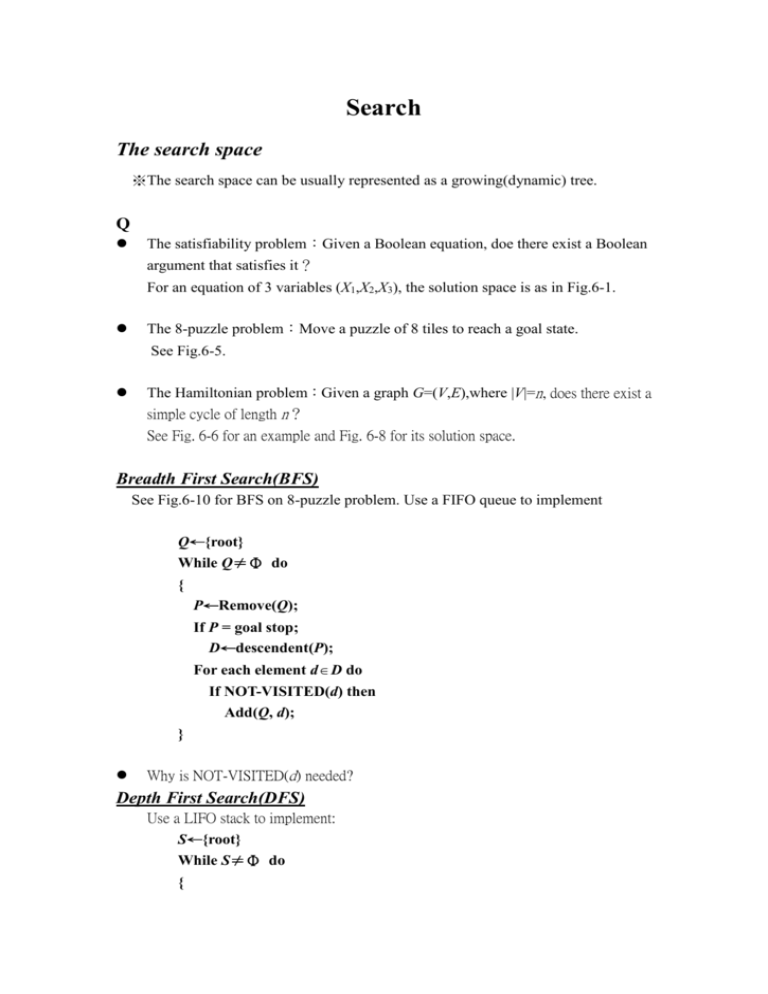Best-First Search
advertisement

Search
The search space
※The search space can be usually represented as a growing(dynamic) tree.
Q
The satisfiability problem:Given a Boolean equation, doe there exist a Boolean
argument that satisfies it?
For an equation of 3 variables (X1,X2,X3), the solution space is as in Fig.6-1.
The 8-puzzle problem:Move a puzzle of 8 tiles to reach a goal state.
See Fig.6-5.
The Hamiltonian problem:Given a graph G=(V,E),where |V|=n, does there exist a
simple cycle of length n?
See Fig. 6-6 for an example and Fig. 6-8 for its solution space.
Breadth First Search(BFS)
See Fig.6-10 for BFS on 8-puzzle problem. Use a FIFO queue to implement
Q←{root}
While Q≠Φ do
{
P←Remove(Q);
If P = goal stop;
D←descendent(P);
For each element d D do
If NOT-VISITED(d) then
Add(Q, d);
}
Why is NOT-VISITED(d) needed?
Depth First Search(DFS)
Use a LIFO stack to implement:
S←{root}
While S≠Φ do
{
P←Pop(S);
If P = goal stop;
D←descendent(P);
For each element d D do
If NOT-VISITED(d) then
Push(S, d);
}
Sometimes, the solutions tend to lie in the leaf of the tree.
Q
The Hamiltonian Path problem:
See Fig.6-13
Hill Climbing
A variant of DFS that uses a heuristic to order the descendents when expanding.
Q
The 8-puzzle problem
Define the evaluation function f(n) on a node n to be the number of misplaced
tiles compared to the goal node.
See Fig.6-15
S←{root}
While S≠Φ do
{
P←Pop(S);
If P = goal stop;
D←descendent(P);
For each element d D in descending order of f(d) do
If NOT-VISITED(d) then
Push(S, d);
}
Best-First Search
A hybrid approach of DFS and BFS, it uses an evaluation function to determine
among all candidate nodes,a node w/ least cost.
Use a heap to implement Best-First Search
H←{root}
While H≠Φ do
{
P←ExtractMin(H);
If P = goal stop;
D←descendent(P);
For each element d D do
If NOT-VISITED(d) then
Insert(H, d);
}
All the problems discussed so far are decision problems, rather than optimal
problems.
An optimization problem is the one that finds a solution among all feasible
solution that is optimal on some function.
Branch and Bound
See Fig.6-19 for the shortest path problem
Q
Personal assignment problem
Input:
a list of n persons ordered by some measure <P1,P2,P3,…Pn>
a partial orders < on n jobs
{ J1,J2,J3,…Jn}
a cost function Cij as the cost for assigning Pi to Jj
Output:
A bijection f from persons to jobs with the minimal cost
s.t. f(Pi)≦f(Pj) implies Pi < Pj
See Fig.6-21 for an example.
Observation:
Each topologically sorted sequence of jobs represents a feasible solution.
Traversing the topologically sorted sequence is like searching the corresponding
tree of partial order on jobs. See Fig.6-22
After we find a feasible solution, we get an Upper bound.
For each node, we can derive its Lower bound.
If the lower bound of a node is no less than the current upper bound, it can be
pruned.
What is the Lower bound of node 1 in page 6-23?
※intuitive solution:29
※considerate solution:17+54
See table 6-2
Q
The 0/1 Knapsack problem
Input
profits of n items:P1,P2,…Pn
weights of n items:W1,W2,…Wn
maximun weight a thief can carry: M
Output
A set of items that maximize the profits while under the thief’s carrying
capacity.
Formal representation
Xi = 0 or 1, 1≦i≦n
n
Maximize
PiXi
i 1
n
Subject to
WiXi ≦ M
i 1
Transform to
n
Minimize
PiXi
i 1
n
Subject to
WiXi ≦ M
i 1
The search space is shown in Fig.6-28
A node should be bounded if
1. A node represents an infeasible solution
2. The lower bound of the node is higher than or equal to the presently found
global upper bound.
3.
The lower bound of the node is equal to its upper bound
In case 3, this lower/upper bound could become the new global upper bound.
Cases 1 and 2, however, should be pruned
A branch is placed on a node with the smaller lower bound.
※ How to find the lower bound of a node
※Use (continuous) Knapsack problem
※ How to find the upper bound of a node
※Use greedy problem
See Example at the bottom of 323
For X1=X2=1
The lower bound is -(P1+P2+
as W1+W2+
5
* P3)
8
3
* W3 = M = 34.
8
The upper bound is -(P1+P2)
Job Scheduling Problem
Input:
1. A partial order of jobs
2. A sequence of numbers, each of which represents the number of available
processors at a particular time slot.
Assume:
1. Each job taken one unit of time to execute.
2. A processor can do any job, provided all the ancestors of the job complete.
Output:
A sequence of job sets, each of which indicates the job set that can be
co-executed at a particular time slot.
Goal:
Minimize the length of the execution sequence.
See Fig.6-29, 6-30 and 6-31 for an example.
Heuristics:
1.
For any pair of job sets that yield the same descendant sets, arbitrarily choose
one.
e.q. (C.E) and (D,P) of Fig.6-31 at level 2.
2.
3.
4.
Priority is given to internal nodes when it comes to expand.
A schedule S will not be optimal if P(S,i) P(S’,i) for some other schedules
where P(S,i) indicates the set of completed jobs at time slot i.
See Fig.6-34
If the number of accumulated processors of a schedule S is greater than that of a
feasible schedule, S cannot be optimal.
See Fig.6-34
The A* Algorithm
We can view A* as a specialization of the more general branch and bound strategy.
The algorithm proceeds as follows:
1. Each node n in the search tree is associated with the following cost functions:
g(n) ≡ the path length from root to n.
h*(n) ≡ the optimal path length from n to goal.
f*(n) = g(n) + h*(n) ≡ the cost of n.
h(n) ≡ the estimation of h*(n), where h(n) ≦ h*(n) n.
f(n) = g(n)+h(n) ≡ the cost function of n.
2.
The search is conducted by using best first search with f(n) being the cost
function.
3.
A* algorithm stops iff the selected node is also a goal node.
Q
See Fig.6-36 and P.341 for an example.
h(n) ≡ the minimum of all the outgoing edge lengths.
8-puzzle in Fig.6-15 (P.303)
Theorem. The solution returned by A* must be optimal.
Proof:
Let t be the selected goal node, and n a node already expanded.
(1) f(t) ≦ f(n) n , because of the best-first-search procedure.
(2) f(t) ≦ f(n) ≦ f*(n) by definition
(3) But one of f*(n)’s must be optimal.
Let f*(s) denote the value of an optimal solution.
f(t) ≦ f(s) ≦f*(s)
But f(t) is the value of a feasible solution
f(t) ≧ f*(s) f(t) = f*(s)
Q
Channel Assignment Problem
Input:A set of intervals with integer terminals.
Output:An assignment of intervals to tracks.
Horizontal constraint:intervals that are assigned to the same track do not intersect.
Vertical constraint:intervals with the same terminals do not intersect vertically.
Legal
illegal
Goal:An assignment using the least number of tracks.
See Fig.6-40,6-41,6-42,6-43,6-44,6-45.
Algorithm.
A.
Form a search tree
1. From vertical constraint graph, choose a sets of nodes whose in-degree = 0.
2. For the subgraph of horizontal constraint graph formed by S, find its
maximum cliques.
3. Each maximum clique represents a possible track. Delete these nodes from
the horizontal and vertical constraint graph, go to step 1.
B.
Define the cost function and conduct the search
h(n) ≡ the minimum number of tracks needed to accommodate all
unscheduled intervals at n.
Use A* to search and it terminates as soon as the goal node is found.
See Fig.6-48 for an example.




